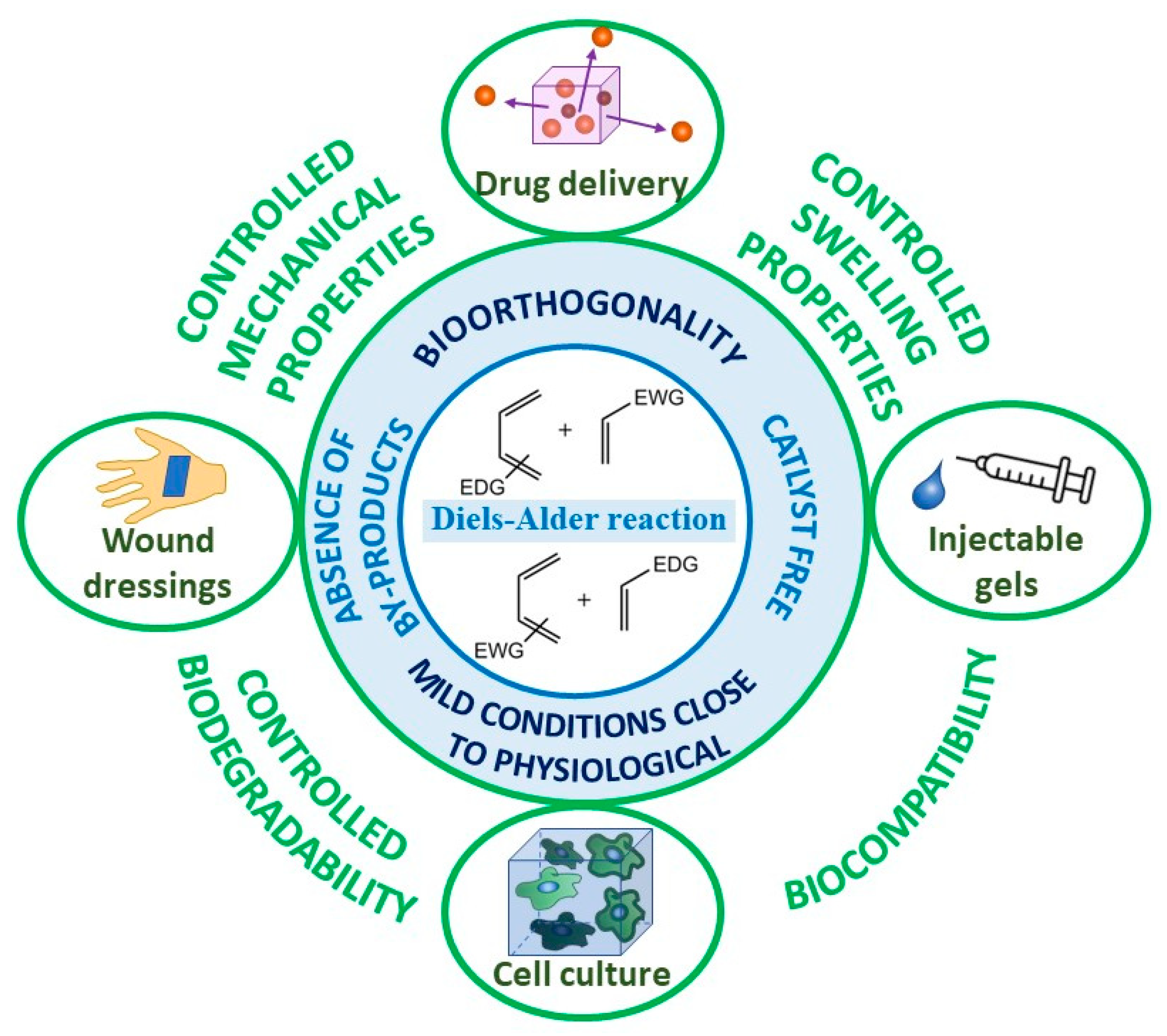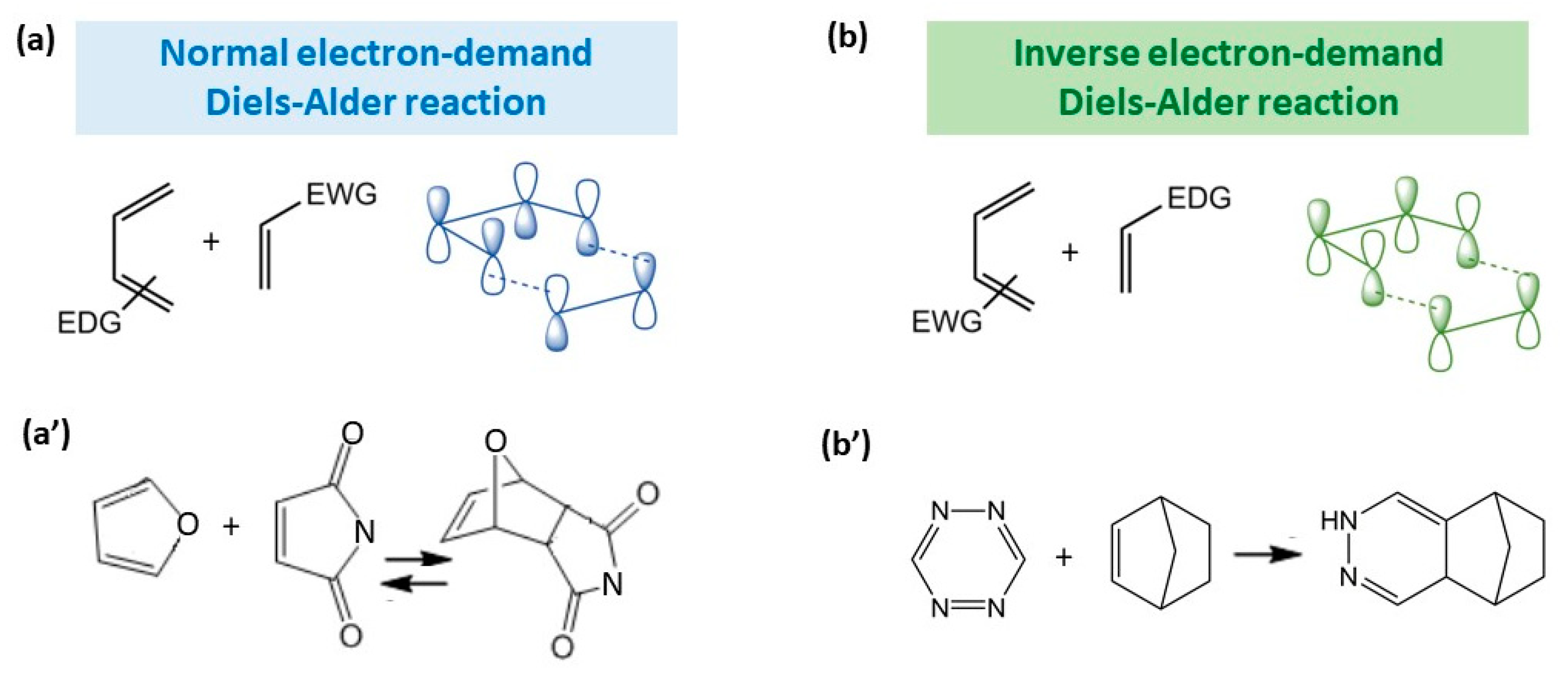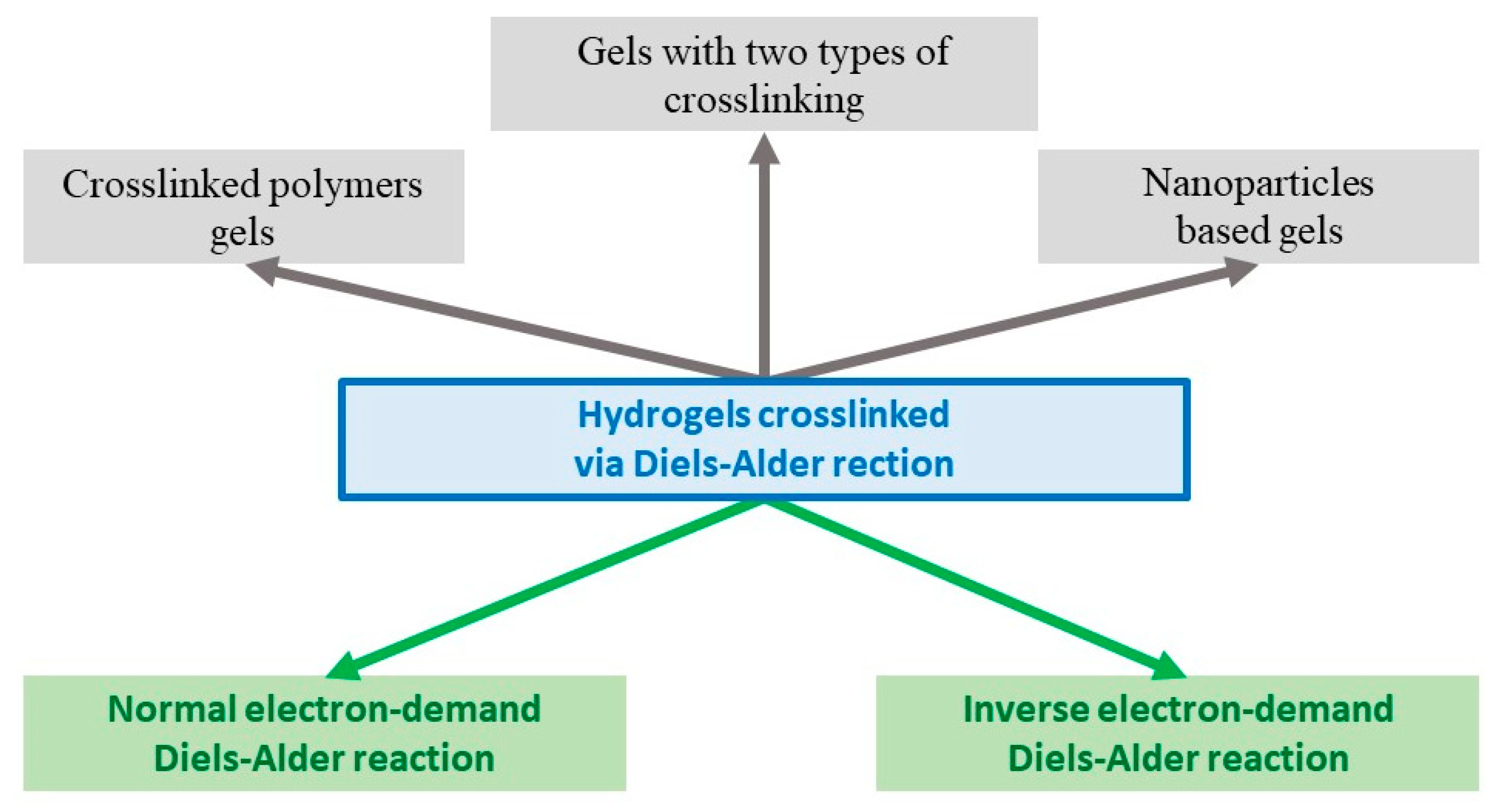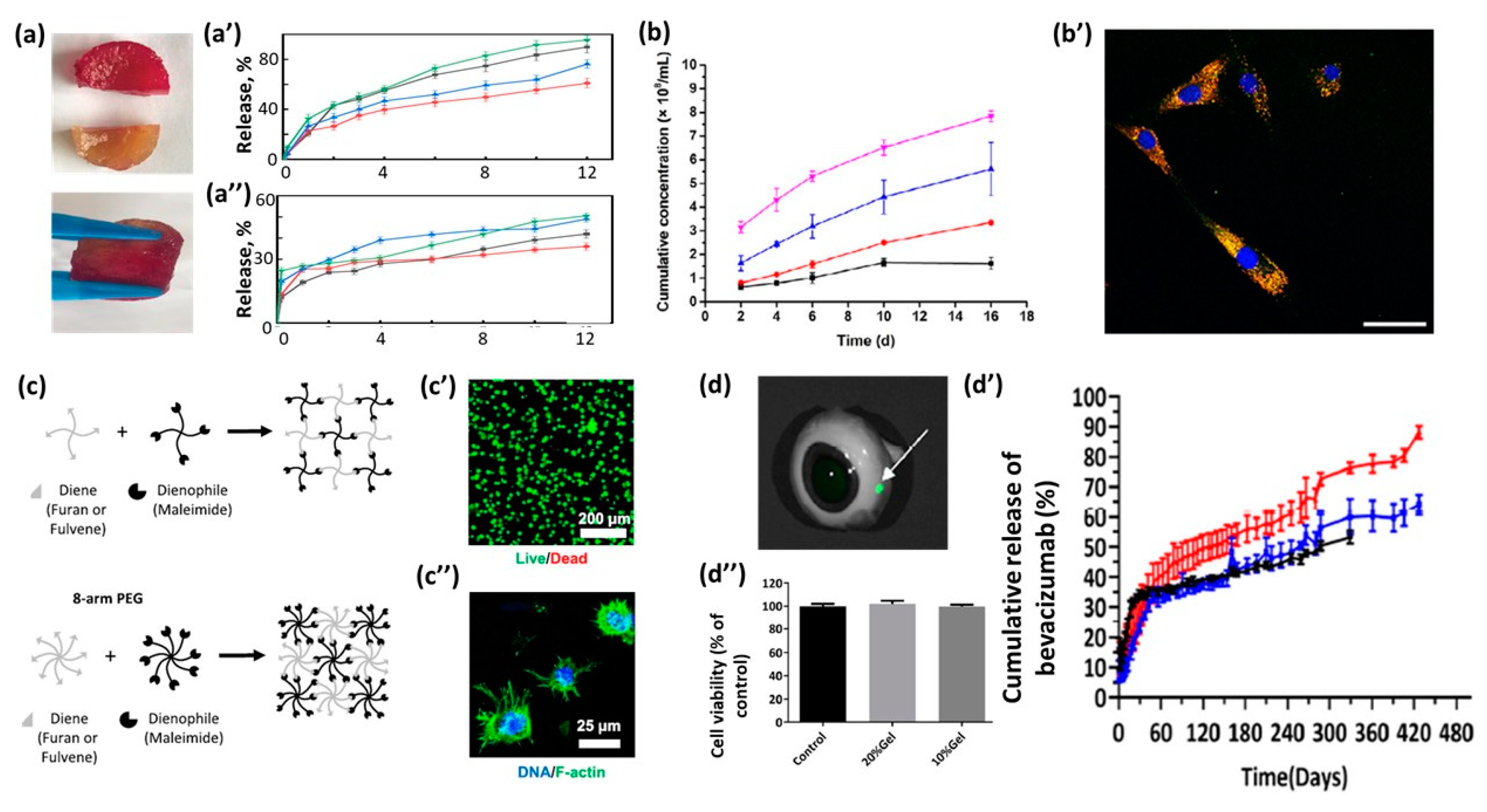Recent Advances in Hydrogels via Diels–Alder Crosslinking: Design and Applications
Abstract
:1. Introduction
2. Hydrogels via Diels–Alder Crosslinking
2.1. Classification
2.2. Hydrogel Design
2.2.1. Normal Electron-Demand DA
2.2.2. Inverse Electron-Demand DA
2.3. Application
2.3.1. Drug Delivery
2.3.2. Cell Culture
2.3.3. Injectable Gels
2.3.4. Other Applications
3. Conclusions
- (i)
- Obtaining diene–dienophilic pairs capable of reacting reversibly under mild (biologically relevant) conditions (below 45 °C). For a standard furan–maleimide pair, the reversible DA reaction occurs above 100 °C [20], depending on the functional groups, which is suitable for self-healing materials, but too high for biological systems that break down above 45 °C [48], allowing for the expansion of biomedical applications by imparting self-healing properties; existing examples approached the temperature of the reverse DA in 50–60 °C [49,50]; however, the reaction occurred in non-aqueous media.
- (ii)
- Novel applications of DA-based hydrogels, for example, the use of DA hydrogels as the basis of inks for 3D bioprinting (i.e., the presence of cells in the ink), which is possible due to the biorthogonality of the DA reaction and is promising for regenerative medicine and tissue engineering; existing works have already shown the possibility of creating injectable gels [16,17,29], including those containing cells [17], but full-fledged 3D objects, such as implants or tissues, have not yet been tested. Another prospective direction is the combination of DA hydrogels with microfluidic technologies to create organs on a chip.
- (iii)
- The development of methods for modifying nanoparticles with fragments capable of participating in the DA reaction to expand the functionality of gels due to the task-specific properties of nanoparticles. For example, obtaining gels with fibrillar structure by using anisotropic particles is beneficial for recapturing the mechanical and permeable properties of the extracellular matrix [51]. The introduction of optically active DA fragments [52] or NPs [53,54], such as quantum dots, upconverting NPs, or plasmonic NPs, could be beneficial for the fabrication of hydrogels with sensing properties. Most of the published works are related to the physical interaction of particles with hydrogel [53], while covalent crosslinking, in particular DA, could avoid toxicity problems due to the strength of the covalent bonding of NPs with hydrogels and the improved visualization properties.
Funding
Institutional Review Board Statement
Informed Consent Statement
Data Availability Statement
Acknowledgments
Conflicts of Interest
References
- Diels, O.; Alder, K. Synthesen in der hydroaromatischen Reihe. Justus Liebigs Ann. Chem. 1928, 460, 98–122. [Google Scholar] [CrossRef]
- Mali, G.; Chauhan, A.N.S.; Chavan, K.A.; Erande, R.D. Development and Applications of Double Diels-Alder Reaction in Organic Synthesis. Asian J. Org. Chem. 2021, 10, 2848–2868. [Google Scholar] [CrossRef]
- Briou, B.; Ameduri, B.; Boutevin, B. Trends in the Diels–Alder reaction in polymer chemistry. Chem. Soc. Rev. 2021, 50, 11055–11097. [Google Scholar] [CrossRef]
- Ratwani, A.; Abdelkader, C.R. Self-healing by Diels-Alder cycloaddition in advanced functional polymers: A review. Prog. Mater. Sci. 2022, 131, 101001. [Google Scholar] [CrossRef]
- Ganz, H.; Harijan, D.; Wagenknecht, D. Labelling of DNA and RNA in the cellular environment by means of bioorthogonal cycloaddition chemistry. RSC Chem. Biol. 2020, 1, 86–97. [Google Scholar] [CrossRef] [PubMed]
- Nihal, T.; Sanyal, A. Furan-containing polymeric Materials: Harnessing the Diels-Alder chemistry for biomedical applications. Eur. J. Org. Chem. 2021, 153, 110514. [Google Scholar] [CrossRef]
- Cadamuro, F.; Russo, L.; Nicotra, F. Biomedical Hydrogels Fabricated Using Diels–Alder Crosslinking. Biomaterials 2021, 3, 374–382. [Google Scholar] [CrossRef]
- Tasdelen, M.A. Diels–Alder “click” reactions: Recent applications in polymer and material science. Polym. Chem. 2011, 2, 2133–2145. [Google Scholar] [CrossRef]
- Richtering, W.; Saunders, B.R. Gel architectures and their complexity. Soft Matter 2014, 10, 3695–3702. [Google Scholar] [CrossRef] [Green Version]
- Guaresti, O.; Astrain, C.; Aguirresarobe, R.; Eceiza, A.; Gabilondo, N. Synthesis of stimuli–Responsive chitosan–Based hydrogels by Diels–Alder cross–Linking ‘click’ reaction as potential carriers for drug administration. Carbohydr. Polym. 2018, 183, 278–286. [Google Scholar] [CrossRef]
- Wei, H.; Li, S.; Liu, Z.; Chen, H.; Liu, Y.; Li, W. Preparation and characterization of starch-cellulose interpenetrating network hydrogels based on sequential Diels-Alder click reaction and photopolymerization. Int. J. Biol. Macromol. 2022, 194, 962–973. [Google Scholar] [CrossRef] [PubMed]
- Li, D.; Wang, S.; Meng, Y.; Guo, Z.; Cheng, M.; Li, J. Fabrication of self-healing pectin/chitosan hybrid hydrogel via Diels-Alder reactions for drug delivery with high swelling property, pH-responsiveness, and cytocompatibility. Carbohydr. Polym. 2021, 268, 118244. [Google Scholar] [CrossRef] [PubMed]
- Jo, Y.; Gulfam, M.; Jo, S.; Gal, Y.; Oh, C.; Park, S.; Taek, K. Multi-stimuli responsive hydrogels derived from hyaluronic acid for cancer therapy application. Carbohydr. Polym. 2022, 286, 119303. [Google Scholar] [CrossRef] [PubMed]
- Delplace, V.; Nickerson, P.; Ortin-martinez, A.; Baker, A.; Wallace, V.; Shoichet, M. Nonswelling, Ultralow Content Inverse Electron-Demand Diels–Alder Hyaluronan Hydrogels with Tunable Gelation Time: Synthesis and In Vitro Evaluation. Adv. Funct. Mater. 2020, 30, 1903978. [Google Scholar] [CrossRef]
- Madl, C.; Heilshorn, S. Rapid Diels–Alder Cross-linking of Cell Encapsulating Hydrogels. Chem. Mater. 2019, 31, 8035–8043. [Google Scholar] [CrossRef] [PubMed]
- Bi, B.; Ma, M.; Lv, S.; Zhuo, R.; Jiang, X. In-situ forming thermosensitive hydroxypropyl chitin-based hydrogel crosslinked by Diels-Alder reaction for three dimensional cell culture. Carbohydr. Polym. 2019, 212, 368–377. [Google Scholar] [CrossRef]
- Yan, A.; Gundsambuu, J.; Krasowska, B.; Paltts, M.; Marina, K.; Gerber, P.F.; Barry, C.; Blencowe, S.C. Injectable Diels-Alder cycloaddition hydrogels with tuneable gelation, stiffness and degradation for the sustained release of T-lymphocytes. J. Mater. Chem. B 2022, 10, 3329–3343. [Google Scholar] [CrossRef]
- Wei, M.; Hsu, Y.; Asoh, T.; Sung, M.; Uyama, H. Injectable poly(c-glutamic acid)-based biodegradable hydrogels with tunable gelation rate and mechanical strength. J. Mater. Chem. B 2021, 9, 3584–3594. [Google Scholar] [CrossRef]
- Zhou, C.; Sheng, C.; Chen, J.; Liang, Y.; Liu, Q.; Li, P.; Huang, X.; Liu, B. Gradual hydrogel degradation for programable repairing full-thickness skin defect wound. Chem. Eng. J. 2022, 450, 138200. [Google Scholar] [CrossRef]
- Vauthier, F.; Jierry, M.; Oliveira, L.; Hassouna, J.C.; Roucoules, L.; Gall, V.B.-L. Interfacial thermoreversible chemistry on functional coatings: A focus on the Diels–Alder reaction. Adv. Funct. Mater. 2019, 29, 1806765. [Google Scholar] [CrossRef]
- Nicolaou, K.C.; Snyder, S.A.; Montagnon, T.; Vassilikogiannakis, G. The Diels–Alder reaction in total synthesis. Angew. Chem. Int. Ed. 2002, 41, 1668–16698. [Google Scholar] [CrossRef]
- Bachmann, W.E.; Deno, N.C. The Diels–Alder Reaction of 1-Vinylnaphthalene with α,β- and α,β,γ,δ-Unsaturated Acids and Derivatives. J. Am. Chem. Soc. 1949, 71, 3062–3072. [Google Scholar] [CrossRef]
- Png, Z.M.; Zeng, H.; Ye, Q.; Xu, J. Inverse-Electron-Demand Diels–Alder Reactions: Principles and Applications. Chem. Asian J. 2019, 12, 2142–2159. [Google Scholar] [CrossRef] [PubMed]
- Farhat, W.; Venditti, R.; Becquart, F.; Ayoub, A.; Majeste, J.; Taha, M.; Mignard, N.; De Lyon, U. Synthesis and Characterization of Thermoresponsive Xylan Networks by Diels–Alder Reaction. ACS Appl. Polym. Mater. 2019, 1, 856–866. [Google Scholar] [CrossRef]
- Delplace, V.; Pickering, A.; Hettiaratchi, M.; Zhao, S.; Kivija, T.; Shoichet, M. Inverse Electron-Demand Diels–Alder Methylcellulose Hydrogels Enable the Co-Delivery of Chondroitinase ABC and Neural Progenitor Cells. Biomacromolecules 2020, 21, 2421–2431. [Google Scholar] [CrossRef] [PubMed]
- Shao, C.; Wang, M.; Chang, H.; Xu, F.; Yang, J. A Self-Healing Cellulose Nanocrystal-Poly(ethylene glycol) Nanocomposite Hydrogel via Diels–Alder Click Reaction. ACS Sustain. Chem. Eng. 2017, 5, 6167–6174. [Google Scholar] [CrossRef]
- Yang, Y.; Zhu, Z.; Gao, R.; Yuan, J.; Zhang, J.; Li, H. Acta Biomaterialia Controlled release of MSC-derived small extracellular vesicles by an injectable Diels-Alder crosslinked hyaluronic acid/PEG hydrogel for osteoarthritis improvement. Acta Biomater. 2021, 128, 163–174. [Google Scholar] [CrossRef] [PubMed]
- Zhang, M.; Wang, J.; Jin, Z. Supramolecular hydrogel formation between chitosan and hydroxypropyl β-cyclodextrin via Diels-Alder reaction and its drug delivery. Int. J. Biol. Macromol. 2018, 114, 381–391. [Google Scholar] [CrossRef]
- Ilochonwu, B.; Mihajlovic, M.; Maas-bakker, R.; Rousou, C.; Tang, M.; Chen, M.; Hennink, W.; Vermonden, T. Hyaluronic Acid-PEG-Based Diels–Alder In Situ Forming Hydrogels for Sustained Intraocular Delivery of Bevacizumab. Biomacromolecules 2022, 23, 2914–2929. [Google Scholar] [CrossRef]
- Li, S.; Wang, L.; Yu, X.; Wang, C.; Wang, Z. Synthesis and characterization of a novel double cross-linked hydrogel based on Diels-Alder click reaction and coordination bonding. Mater. Sci. Eng. C 2018, 82, 299–309. [Google Scholar] [CrossRef]
- Wei, Q.; Bai, J.; Wang, H.; Ma, G.; Li, X.; Zhang, W.; Hu, Z. Photo-induced programmable degradation of carboxymethyl chitosan-based hydrogels. Carbohydr. Polym. 2021, 256, 117609. [Google Scholar] [CrossRef] [PubMed]
- Hu, X.; Gao, Z.; Tan, H.; Wang, H.; Mao, X. An Injectable Hyaluronic Acid-Based Composite Hydrogel by DA Click Chemistry With pH Sensitive Nanoparticle for Biomedical Application. Front. Chem. 2019, 7, 477. [Google Scholar] [CrossRef] [PubMed] [Green Version]
- Online, V.; Gandini, A.; Algar, I.; Eceiza, A.; Corcuera, M.; Gabilondo, N. Diels–Alder “click” chemistry for the cross-linking of furfuryl-gelatin-polyetheramine hydrogels. RSC Adv. 2014, 4, 35578–35587. [Google Scholar] [CrossRef]
- González, K.; Gurrea, T.; Guaresti, O.; Algar, I.; Eceiza, A.; Gabilondo, N. Maleimide-grafted cellulose nanocrystals as cross-linkers for bionanocomposite hydrogels. Carbohydr. Polym. 2016, 149, 94–101. [Google Scholar] [CrossRef]
- Miljevic, M.; Ahmed, I.; Martin, L.; Eceiza, A.; Fruk, L.; Corcuera, M. Designing hydrogel nanocomposites using TiO2 as clickable cross-linkers. J. Mater. Sci. 2016, 51, 5073–5081. [Google Scholar] [CrossRef]
- Garc, C.; Chen, C.; Palomares, T.; Eceiza, A.; Fruk, L. Biocompatible Hydrogel Nanocomposite with Covalently Embedded Silver Nanoparticles. Biomacromolecules 2015, 16, 1301–1310. [Google Scholar] [CrossRef]
- Matter, M.; Luna, F.; Niederberg, A. From colloidal dispersions to aerogels: How to master nanoparticle gelation. Nano Today 2020, 30, 100827. [Google Scholar] [CrossRef]
- He, Q.; Lu, X. Design and fabrication strategies of cellulose nanocrystal-based hydrogel and its highlighted application using 3D printing: A review. Carbohydr. Polym. 2022, 301, 120351. [Google Scholar] [CrossRef]
- de Oliveira, M.; Rigolet, J.; Marichal, S.; Roucoules, C.; Laborie, V. Grafting Diels-Alder moieties on cellulose nanocrystals through carbamation. Carbohydr. Polym. 2020, 250, 116966. [Google Scholar] [CrossRef]
- Prince, E.; Chen, Z.; Khuu, N.; Kumacheva, E. Nano fi brillar Hydrogel Recapitulates Changes Occurring in the Fibrotic Extracellular Matrix. Biomacromolecules 2021, 22, 2352–2362. [Google Scholar] [CrossRef]
- Storm, P.; Pastore, C.; MacKintosh, J.; Lubensky, F.; Janmey, T. Nonlinear elasticity in biological gels. Nature 2005, 435, 191–194. [Google Scholar] [CrossRef] [PubMed] [Green Version]
- Li, J.; Mooney, D. Designing hydrogels for controlled drug delivery. Nat. Rev. Mater. 2016, 1, 16071. [Google Scholar] [CrossRef]
- Morozova, S.; Statsenko, T.; Ryabchenko, E.; Gevorkian, A.; Adibnia, V.; Lozhkin, M.; Kireynov, A.V.; Kumacheva, E. Multicolored Nanocolloidal Hydrogel Inks. Adv. Funct. Mater. 2021, 31, 2105470. [Google Scholar] [CrossRef]
- Li, Y.; Khuu, N.; Gevorkian, A.; Sarjinsky, S.; Therien-aubin, H.; Wang, Y.; Cho, S.; Kumacheva, E. Supramolecular Nanofibrillar Thermoreversible Hydrogel for Growth and Release of Cancer Spheroids. Angew. Chem. Int. Ed. 2017, 56, 6083–6087. [Google Scholar] [CrossRef]
- Wang, S.; Heilshorn, H. Adaptable hydrogel networks with reversible linkages for tissue engineering. Adv. Mater. 2015, 27, 3717–3736. [Google Scholar] [CrossRef] [PubMed]
- Uman, S.; Dhand, A.; Burdick, J. Recent advances in shear-thinning and self-healing hydrogels for biomedical applications. J. Appl. Polym. Sci. 2020, 137, 48668. [Google Scholar] [CrossRef] [Green Version]
- Kashparova, N.; Chernysheva, V.; Klushin, D.; Andreeva, V.; Kravchenko, V.; Smirnova, O. Furan monomers and polymers from renewable plant biomass. Russ. Chem. Rev. 2021, 90, 750. [Google Scholar] [CrossRef]
- He, X. Thermostability of biological systems: Fundamentals, challenges, and quantification. Open Biomed. Eng. J. 2011, 5, 47–73. [Google Scholar] [CrossRef]
- Roy, J.; Lehn, N. Dynamic Covalent Chemistry: A Facile Room-Temperature, Reversible, Diels–Alder Reaction between Anthracene Derivatives and N-Phenyltriazolinedione. Chem. Asian J. 2011, 6, 2419–2425. [Google Scholar] [CrossRef]
- Arrizabalaga, D.; Casey, J.; Becca, J.; Jensen, J.; Hayes, L. Comparison of thermoresponsive Diels-Alder linkers for the release of payloads from magnetic nanoparticles via hysteretic heating. JCIS Open 2021, 4, 100034. [Google Scholar] [CrossRef]
- Liu, K.; Wiendels, M.; Yuan, H.; Ruan, C.; Kouwer, P.H. Cell-matrix reciprocity in 3D culture models with nonlinear elasticity. Bioact. Mater. 2022, 9, 316–331. [Google Scholar] [CrossRef] [PubMed]
- Jiang, N.; Hadjichristidis, Y. Diels–Alder Polymer Networks with Temperature-Reversible Cross-Linking-Induced Emission. Angew. Chem. 2021, 133, 335–341. [Google Scholar] [CrossRef]
- Guimarães, C.F.; Ahmed, R.; Marques, A.P.; Reis, R.L.; Demirci, U. Engineering Hydrogel-Based Biomedical Photonics: Design, Fabrication, and Applications. Adv. Mater. 2021, 33, 2006582. [Google Scholar] [CrossRef] [PubMed]
- Morozova, S.; Alikina, M.; Vinogradov, A.; Pagliaro, M. Silicon Quantum Dots: Synthesis, Encapsulation, and Application in Light-Emitting Diodes. Front. Chem. 2020, 8, 191. [Google Scholar] [CrossRef]




| (a) Diene Component | (b) Dienophile Component | ||
|---|---|---|---|
| Description | Reference | Description | Reference |
| Furyl modified Chitin | [16] | 4-arm maleimide-terminated PEG and PEG dimaleimide | [15,16,17,18,19,26,27,29,30,31,32] |
| Furyl modified hyaluronan | [19,27,29,32] | Maleimide-terminated Jeffamine | [10,33] |
| Furyl modified hydroxypropylcellulose | [11] | Maleimide-modified cyclodextrin | [11,28] |
| Furyl modified poly(glutamic acid) | [18] | Bismaleimide | [13] |
| Furyl modified poly(caprolactone) | [24] | Maleimide-modified cellulose nanocrystals | [34] |
| Furyl modified gelatin | [33,34,35,36] | Maleimide-modified Ag NPs | [36] |
| Furyl modified cellulose nanocrystals | [26] | Maleimide-modified TiO2 NPs | [35] |
| Fulven modified PEG | [17] | ||
Disclaimer/Publisher’s Note: The statements, opinions and data contained in all publications are solely those of the individual author(s) and contributor(s) and not of MDPI and/or the editor(s). MDPI and/or the editor(s) disclaim responsibility for any injury to people or property resulting from any ideas, methods, instructions or products referred to in the content. |
© 2023 by the author. Licensee MDPI, Basel, Switzerland. This article is an open access article distributed under the terms and conditions of the Creative Commons Attribution (CC BY) license (https://creativecommons.org/licenses/by/4.0/).
Share and Cite
Morozova, S.M. Recent Advances in Hydrogels via Diels–Alder Crosslinking: Design and Applications. Gels 2023, 9, 102. https://doi.org/10.3390/gels9020102
Morozova SM. Recent Advances in Hydrogels via Diels–Alder Crosslinking: Design and Applications. Gels. 2023; 9(2):102. https://doi.org/10.3390/gels9020102
Chicago/Turabian StyleMorozova, Sofia M. 2023. "Recent Advances in Hydrogels via Diels–Alder Crosslinking: Design and Applications" Gels 9, no. 2: 102. https://doi.org/10.3390/gels9020102





